Study of Innovation Process Model
VerifiedAdded on 2023/01/19
|10
|2666
|81
AI Summary
This document provides an in-depth study of the six generations of the innovation process model. It discusses the characteristics, strengths, limitations, and consequences of each model. The document also highlights the importance of innovation in the marketplace and provides recommendations for improving the innovation process.
Contribute Materials
Your contribution can guide someone’s learning journey. Share your
documents today.
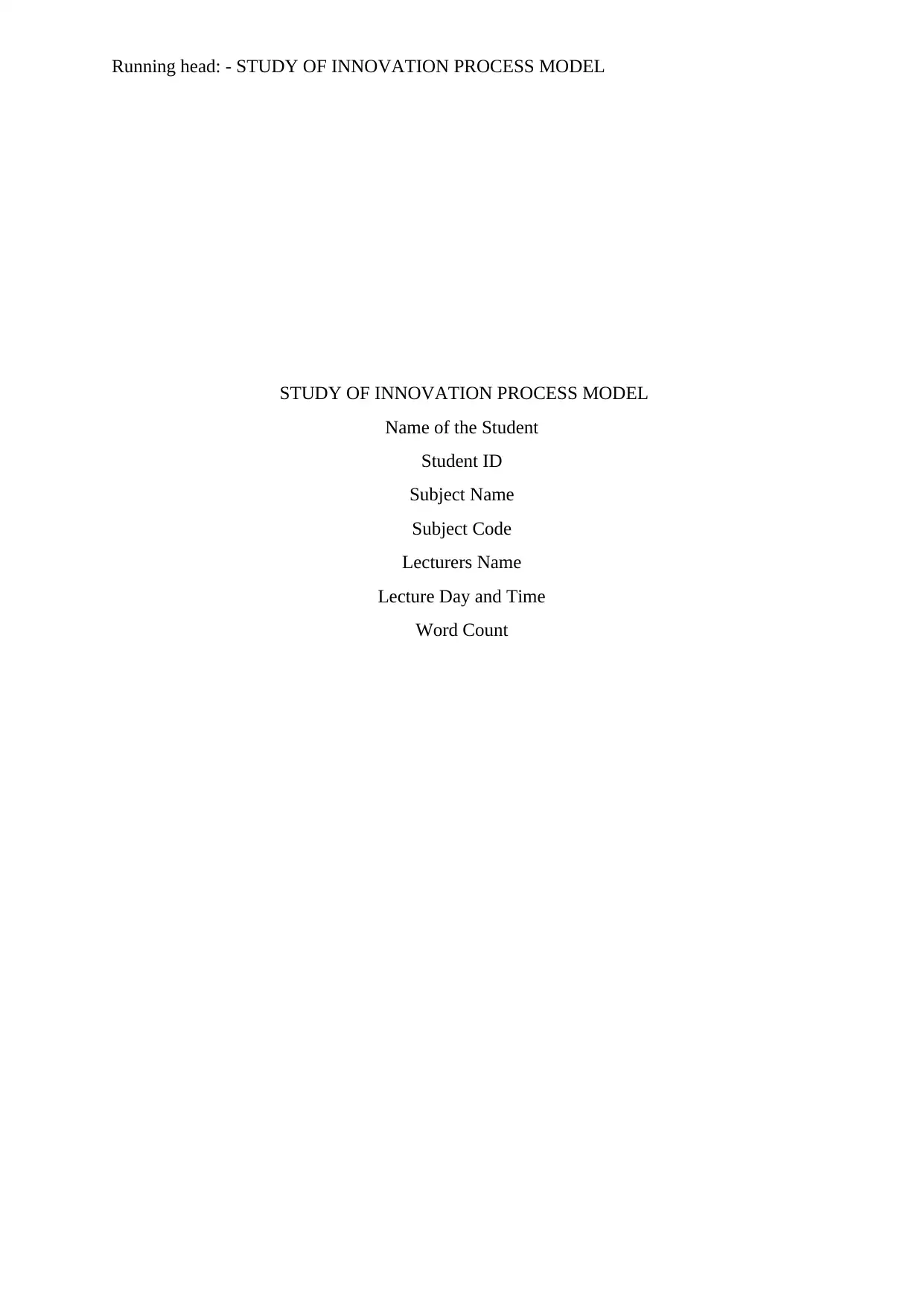
Running head: - STUDY OF INNOVATION PROCESS MODEL
STUDY OF INNOVATION PROCESS MODEL
Name of the Student
Student ID
Subject Name
Subject Code
Lecturers Name
Lecture Day and Time
Word Count
STUDY OF INNOVATION PROCESS MODEL
Name of the Student
Student ID
Subject Name
Subject Code
Lecturers Name
Lecture Day and Time
Word Count
Secure Best Marks with AI Grader
Need help grading? Try our AI Grader for instant feedback on your assignments.
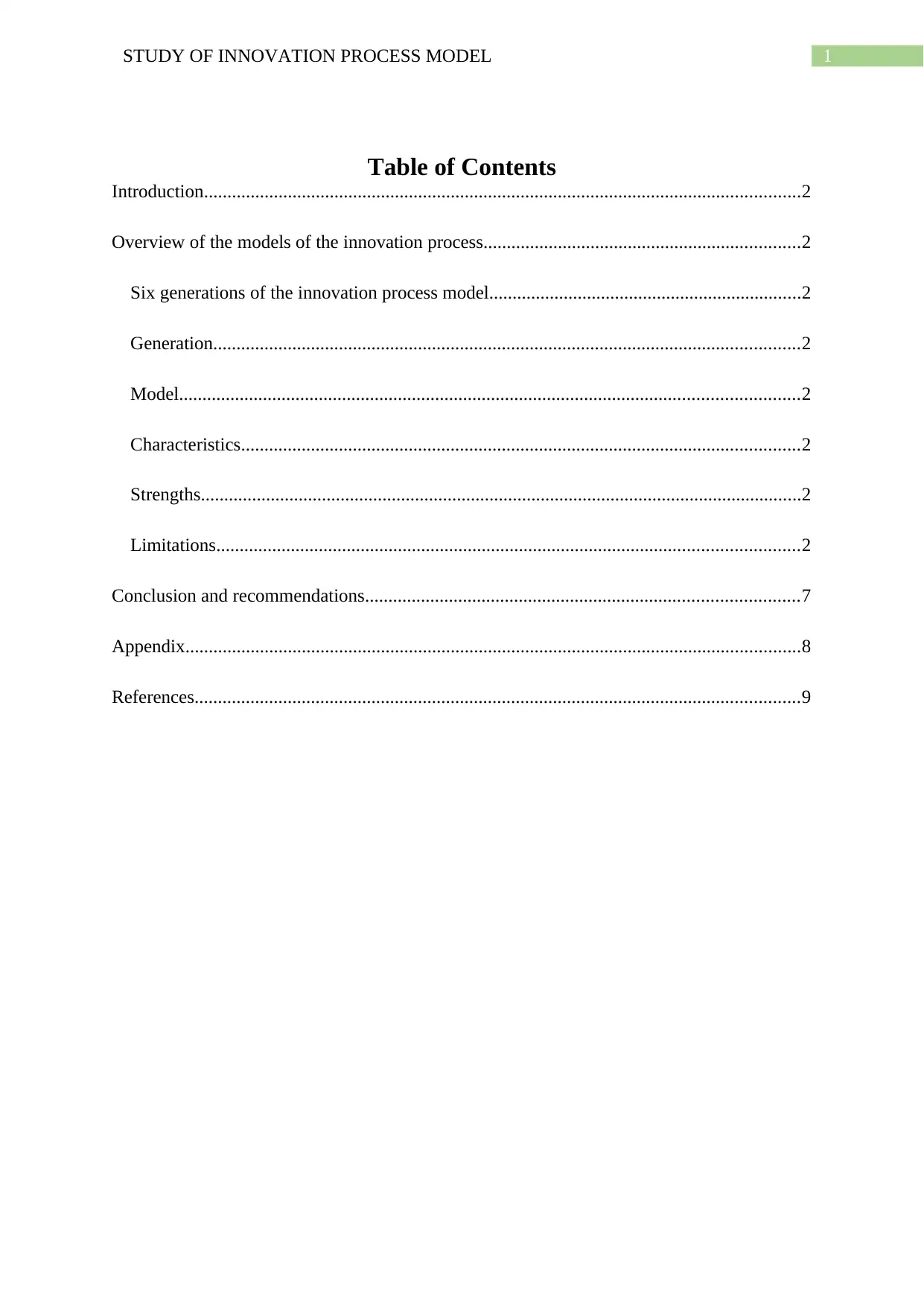
1STUDY OF INNOVATION PROCESS MODEL
Table of Contents
Introduction................................................................................................................................2
Overview of the models of the innovation process....................................................................2
Six generations of the innovation process model...................................................................2
Generation..............................................................................................................................2
Model.....................................................................................................................................2
Characteristics........................................................................................................................2
Strengths.................................................................................................................................2
Limitations.............................................................................................................................2
Conclusion and recommendations.............................................................................................7
Appendix....................................................................................................................................8
References..................................................................................................................................9
Table of Contents
Introduction................................................................................................................................2
Overview of the models of the innovation process....................................................................2
Six generations of the innovation process model...................................................................2
Generation..............................................................................................................................2
Model.....................................................................................................................................2
Characteristics........................................................................................................................2
Strengths.................................................................................................................................2
Limitations.............................................................................................................................2
Conclusion and recommendations.............................................................................................7
Appendix....................................................................................................................................8
References..................................................................................................................................9
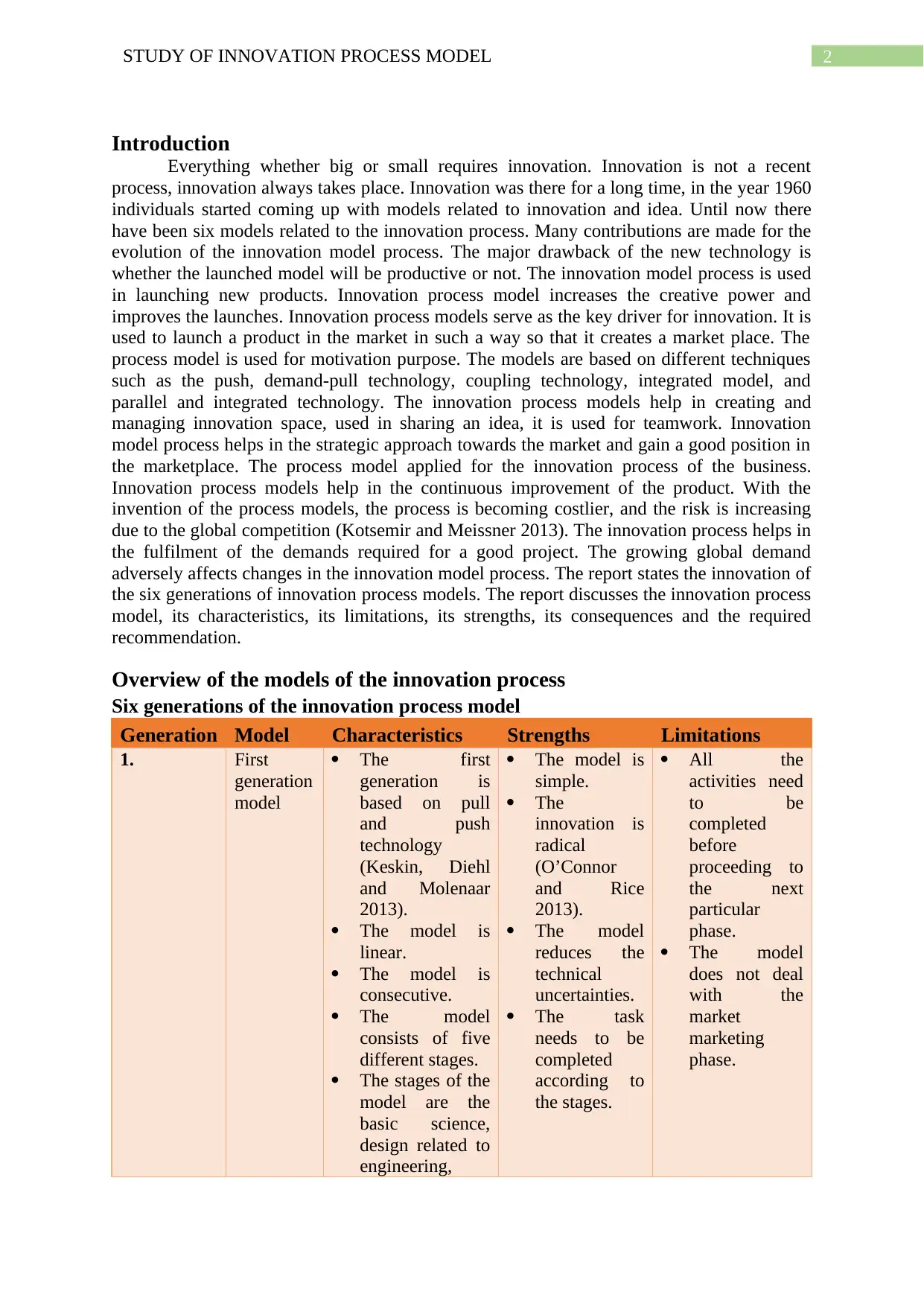
2STUDY OF INNOVATION PROCESS MODEL
Introduction
Everything whether big or small requires innovation. Innovation is not a recent
process, innovation always takes place. Innovation was there for a long time, in the year 1960
individuals started coming up with models related to innovation and idea. Until now there
have been six models related to the innovation process. Many contributions are made for the
evolution of the innovation model process. The major drawback of the new technology is
whether the launched model will be productive or not. The innovation model process is used
in launching new products. Innovation process model increases the creative power and
improves the launches. Innovation process models serve as the key driver for innovation. It is
used to launch a product in the market in such a way so that it creates a market place. The
process model is used for motivation purpose. The models are based on different techniques
such as the push, demand-pull technology, coupling technology, integrated model, and
parallel and integrated technology. The innovation process models help in creating and
managing innovation space, used in sharing an idea, it is used for teamwork. Innovation
model process helps in the strategic approach towards the market and gain a good position in
the marketplace. The process model applied for the innovation process of the business.
Innovation process models help in the continuous improvement of the product. With the
invention of the process models, the process is becoming costlier, and the risk is increasing
due to the global competition (Kotsemir and Meissner 2013). The innovation process helps in
the fulfilment of the demands required for a good project. The growing global demand
adversely affects changes in the innovation model process. The report states the innovation of
the six generations of innovation process models. The report discusses the innovation process
model, its characteristics, its limitations, its strengths, its consequences and the required
recommendation.
Overview of the models of the innovation process
Six generations of the innovation process model
Generation Model Characteristics Strengths Limitations
1. First
generation
model
The first
generation is
based on pull
and push
technology
(Keskin, Diehl
and Molenaar
2013).
The model is
linear.
The model is
consecutive.
The model
consists of five
different stages.
The stages of the
model are the
basic science,
design related to
engineering,
The model is
simple.
The
innovation is
radical
(O’Connor
and Rice
2013).
The model
reduces the
technical
uncertainties.
The task
needs to be
completed
according to
the stages.
All the
activities need
to be
completed
before
proceeding to
the next
particular
phase.
The model
does not deal
with the
market
marketing
phase.
Introduction
Everything whether big or small requires innovation. Innovation is not a recent
process, innovation always takes place. Innovation was there for a long time, in the year 1960
individuals started coming up with models related to innovation and idea. Until now there
have been six models related to the innovation process. Many contributions are made for the
evolution of the innovation model process. The major drawback of the new technology is
whether the launched model will be productive or not. The innovation model process is used
in launching new products. Innovation process model increases the creative power and
improves the launches. Innovation process models serve as the key driver for innovation. It is
used to launch a product in the market in such a way so that it creates a market place. The
process model is used for motivation purpose. The models are based on different techniques
such as the push, demand-pull technology, coupling technology, integrated model, and
parallel and integrated technology. The innovation process models help in creating and
managing innovation space, used in sharing an idea, it is used for teamwork. Innovation
model process helps in the strategic approach towards the market and gain a good position in
the marketplace. The process model applied for the innovation process of the business.
Innovation process models help in the continuous improvement of the product. With the
invention of the process models, the process is becoming costlier, and the risk is increasing
due to the global competition (Kotsemir and Meissner 2013). The innovation process helps in
the fulfilment of the demands required for a good project. The growing global demand
adversely affects changes in the innovation model process. The report states the innovation of
the six generations of innovation process models. The report discusses the innovation process
model, its characteristics, its limitations, its strengths, its consequences and the required
recommendation.
Overview of the models of the innovation process
Six generations of the innovation process model
Generation Model Characteristics Strengths Limitations
1. First
generation
model
The first
generation is
based on pull
and push
technology
(Keskin, Diehl
and Molenaar
2013).
The model is
linear.
The model is
consecutive.
The model
consists of five
different stages.
The stages of the
model are the
basic science,
design related to
engineering,
The model is
simple.
The
innovation is
radical
(O’Connor
and Rice
2013).
The model
reduces the
technical
uncertainties.
The task
needs to be
completed
according to
the stages.
All the
activities need
to be
completed
before
proceeding to
the next
particular
phase.
The model
does not deal
with the
market
marketing
phase.
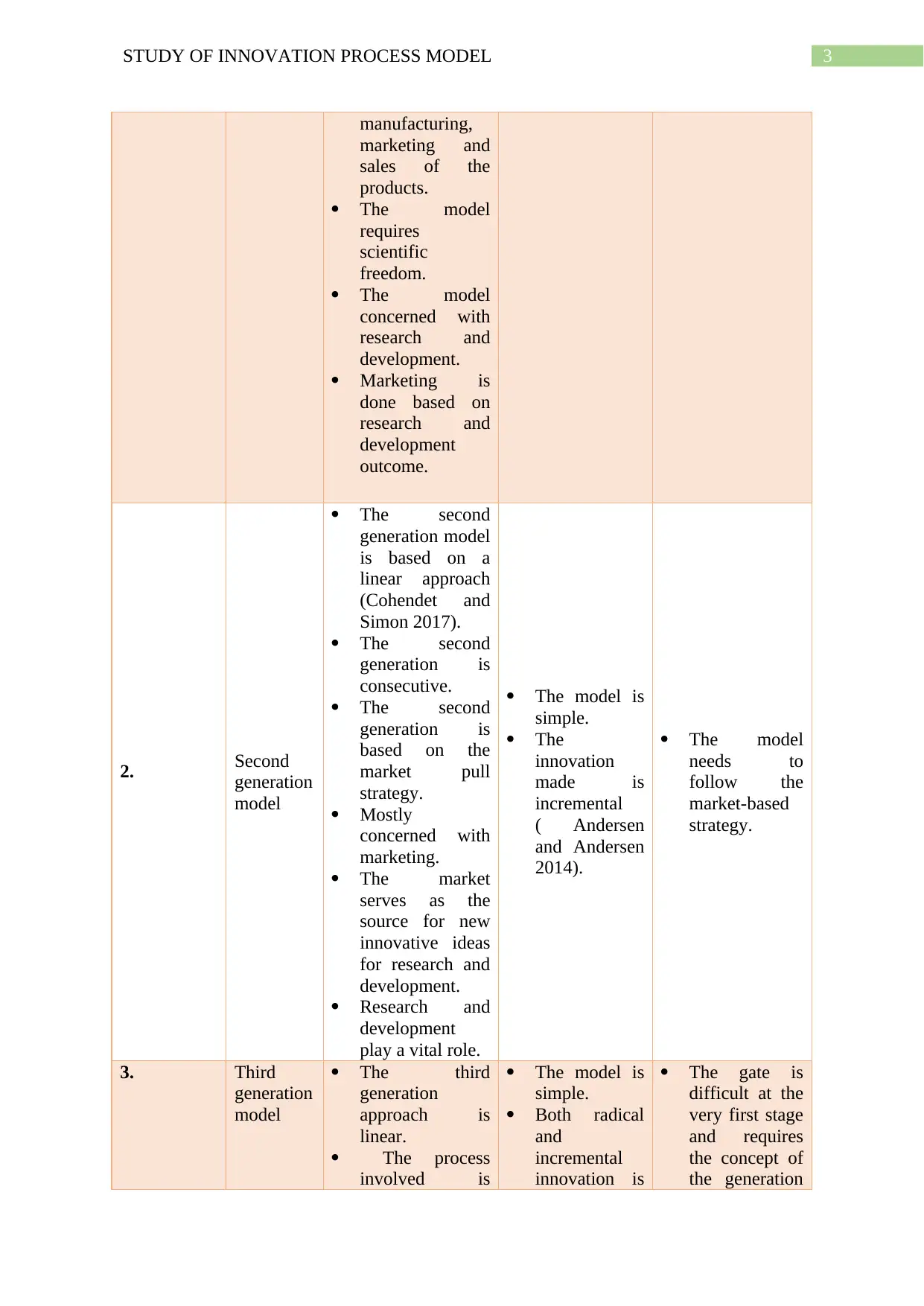
3STUDY OF INNOVATION PROCESS MODEL
manufacturing,
marketing and
sales of the
products.
The model
requires
scientific
freedom.
The model
concerned with
research and
development.
Marketing is
done based on
research and
development
outcome.
2. Second
generation
model
The second
generation model
is based on a
linear approach
(Cohendet and
Simon 2017).
The second
generation is
consecutive.
The second
generation is
based on the
market pull
strategy.
Mostly
concerned with
marketing.
The market
serves as the
source for new
innovative ideas
for research and
development.
Research and
development
play a vital role.
The model is
simple.
The
innovation
made is
incremental
( Andersen
and Andersen
2014).
The model
needs to
follow the
market-based
strategy.
3. Third
generation
model
The third
generation
approach is
linear.
The process
involved is
The model is
simple.
Both radical
and
incremental
innovation is
The gate is
difficult at the
very first stage
and requires
the concept of
the generation
manufacturing,
marketing and
sales of the
products.
The model
requires
scientific
freedom.
The model
concerned with
research and
development.
Marketing is
done based on
research and
development
outcome.
2. Second
generation
model
The second
generation model
is based on a
linear approach
(Cohendet and
Simon 2017).
The second
generation is
consecutive.
The second
generation is
based on the
market pull
strategy.
Mostly
concerned with
marketing.
The market
serves as the
source for new
innovative ideas
for research and
development.
Research and
development
play a vital role.
The model is
simple.
The
innovation
made is
incremental
( Andersen
and Andersen
2014).
The model
needs to
follow the
market-based
strategy.
3. Third
generation
model
The third
generation
approach is
linear.
The process
involved is
The model is
simple.
Both radical
and
incremental
innovation is
The gate is
difficult at the
very first stage
and requires
the concept of
the generation
Secure Best Marks with AI Grader
Need help grading? Try our AI Grader for instant feedback on your assignments.
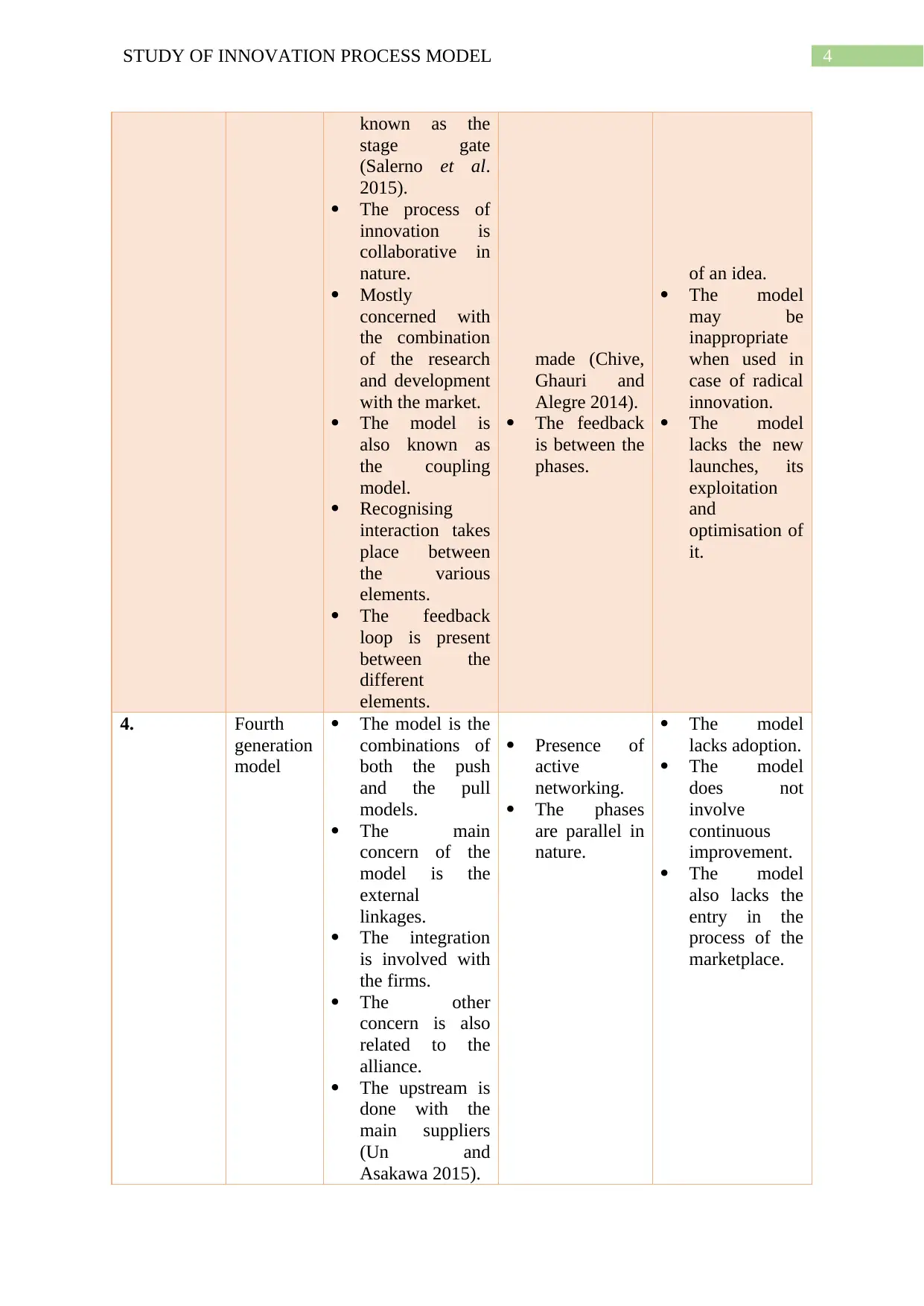
4STUDY OF INNOVATION PROCESS MODEL
known as the
stage gate
(Salerno et al.
2015).
The process of
innovation is
collaborative in
nature.
Mostly
concerned with
the combination
of the research
and development
with the market.
The model is
also known as
the coupling
model.
Recognising
interaction takes
place between
the various
elements.
The feedback
loop is present
between the
different
elements.
made (Chive,
Ghauri and
Alegre 2014).
The feedback
is between the
phases.
of an idea.
The model
may be
inappropriate
when used in
case of radical
innovation.
The model
lacks the new
launches, its
exploitation
and
optimisation of
it.
4. Fourth
generation
model
The model is the
combinations of
both the push
and the pull
models.
The main
concern of the
model is the
external
linkages.
The integration
is involved with
the firms.
The other
concern is also
related to the
alliance.
The upstream is
done with the
main suppliers
(Un and
Asakawa 2015).
Presence of
active
networking.
The phases
are parallel in
nature.
The model
lacks adoption.
The model
does not
involve
continuous
improvement.
The model
also lacks the
entry in the
process of the
marketplace.
known as the
stage gate
(Salerno et al.
2015).
The process of
innovation is
collaborative in
nature.
Mostly
concerned with
the combination
of the research
and development
with the market.
The model is
also known as
the coupling
model.
Recognising
interaction takes
place between
the various
elements.
The feedback
loop is present
between the
different
elements.
made (Chive,
Ghauri and
Alegre 2014).
The feedback
is between the
phases.
of an idea.
The model
may be
inappropriate
when used in
case of radical
innovation.
The model
lacks the new
launches, its
exploitation
and
optimisation of
it.
4. Fourth
generation
model
The model is the
combinations of
both the push
and the pull
models.
The main
concern of the
model is the
external
linkages.
The integration
is involved with
the firms.
The other
concern is also
related to the
alliance.
The upstream is
done with the
main suppliers
(Un and
Asakawa 2015).
Presence of
active
networking.
The phases
are parallel in
nature.
The model
lacks adoption.
The model
does not
involve
continuous
improvement.
The model
also lacks the
entry in the
process of the
marketplace.
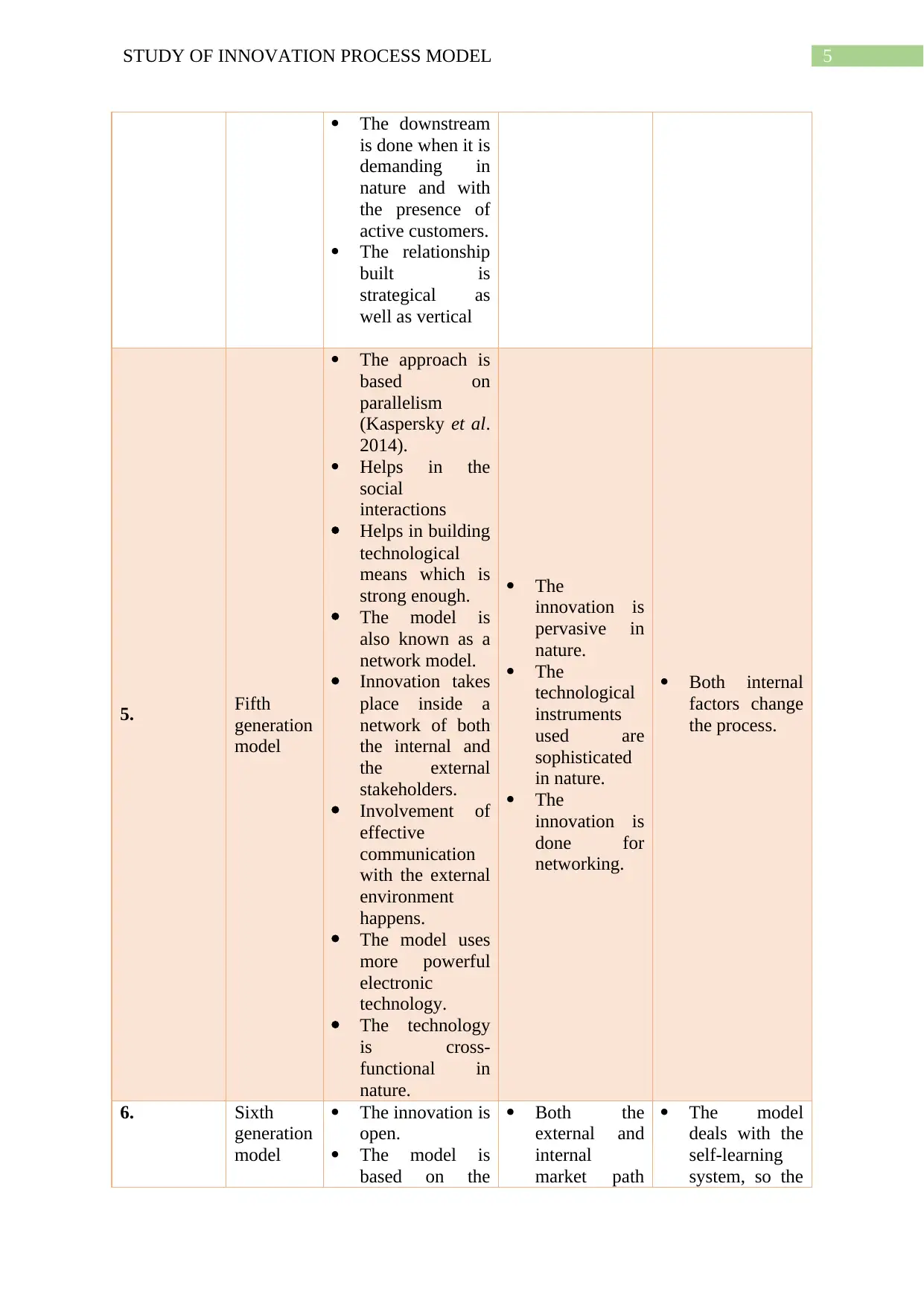
5STUDY OF INNOVATION PROCESS MODEL
The downstream
is done when it is
demanding in
nature and with
the presence of
active customers.
The relationship
built is
strategical as
well as vertical
5. Fifth
generation
model
The approach is
based on
parallelism
(Kaspersky et al.
2014).
Helps in the
social
interactions
Helps in building
technological
means which is
strong enough.
The model is
also known as a
network model.
Innovation takes
place inside a
network of both
the internal and
the external
stakeholders.
Involvement of
effective
communication
with the external
environment
happens.
The model uses
more powerful
electronic
technology.
The technology
is cross-
functional in
nature.
The
innovation is
pervasive in
nature.
The
technological
instruments
used are
sophisticated
in nature.
The
innovation is
done for
networking.
Both internal
factors change
the process.
6. Sixth
generation
model
The innovation is
open.
The model is
based on the
Both the
external and
internal
market path
The model
deals with the
self-learning
system, so the
The downstream
is done when it is
demanding in
nature and with
the presence of
active customers.
The relationship
built is
strategical as
well as vertical
5. Fifth
generation
model
The approach is
based on
parallelism
(Kaspersky et al.
2014).
Helps in the
social
interactions
Helps in building
technological
means which is
strong enough.
The model is
also known as a
network model.
Innovation takes
place inside a
network of both
the internal and
the external
stakeholders.
Involvement of
effective
communication
with the external
environment
happens.
The model uses
more powerful
electronic
technology.
The technology
is cross-
functional in
nature.
The
innovation is
pervasive in
nature.
The
technological
instruments
used are
sophisticated
in nature.
The
innovation is
done for
networking.
Both internal
factors change
the process.
6. Sixth
generation
model
The innovation is
open.
The model is
based on the
Both the
external and
internal
market path
The model
deals with the
self-learning
system, so the
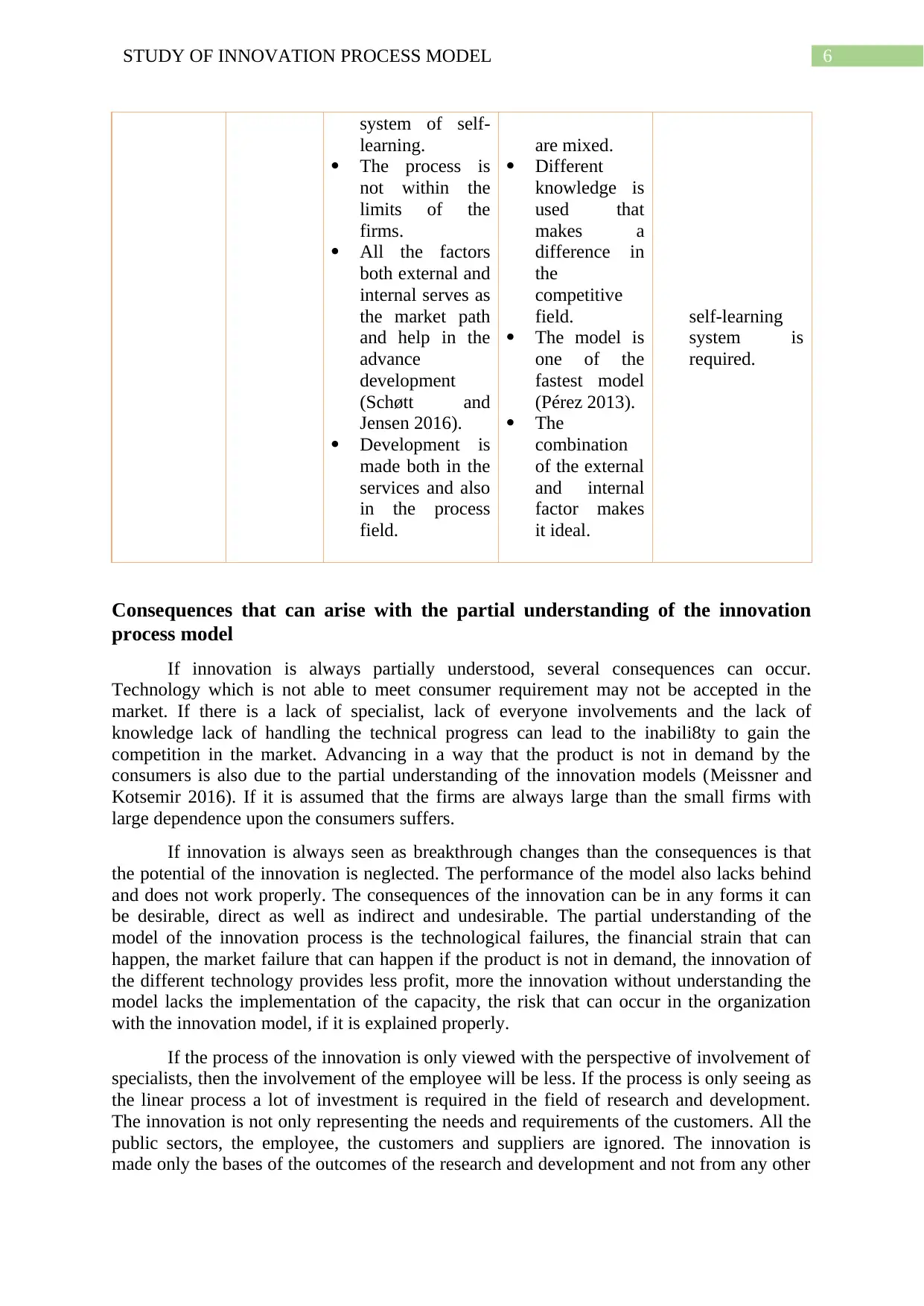
6STUDY OF INNOVATION PROCESS MODEL
system of self-
learning.
The process is
not within the
limits of the
firms.
All the factors
both external and
internal serves as
the market path
and help in the
advance
development
(Schøtt and
Jensen 2016).
Development is
made both in the
services and also
in the process
field.
are mixed.
Different
knowledge is
used that
makes a
difference in
the
competitive
field.
The model is
one of the
fastest model
(Pérez 2013).
The
combination
of the external
and internal
factor makes
it ideal.
self-learning
system is
required.
Consequences that can arise with the partial understanding of the innovation
process model
If innovation is always partially understood, several consequences can occur.
Technology which is not able to meet consumer requirement may not be accepted in the
market. If there is a lack of specialist, lack of everyone involvements and the lack of
knowledge lack of handling the technical progress can lead to the inabili8ty to gain the
competition in the market. Advancing in a way that the product is not in demand by the
consumers is also due to the partial understanding of the innovation models (Meissner and
Kotsemir 2016). If it is assumed that the firms are always large than the small firms with
large dependence upon the consumers suffers.
If innovation is always seen as breakthrough changes than the consequences is that
the potential of the innovation is neglected. The performance of the model also lacks behind
and does not work properly. The consequences of the innovation can be in any forms it can
be desirable, direct as well as indirect and undesirable. The partial understanding of the
model of the innovation process is the technological failures, the financial strain that can
happen, the market failure that can happen if the product is not in demand, the innovation of
the different technology provides less profit, more the innovation without understanding the
model lacks the implementation of the capacity, the risk that can occur in the organization
with the innovation model, if it is explained properly.
If the process of the innovation is only viewed with the perspective of involvement of
specialists, then the involvement of the employee will be less. If the process is only seeing as
the linear process a lot of investment is required in the field of research and development.
The innovation is not only representing the needs and requirements of the customers. All the
public sectors, the employee, the customers and suppliers are ignored. The innovation is
made only the bases of the outcomes of the research and development and not from any other
system of self-
learning.
The process is
not within the
limits of the
firms.
All the factors
both external and
internal serves as
the market path
and help in the
advance
development
(Schøtt and
Jensen 2016).
Development is
made both in the
services and also
in the process
field.
are mixed.
Different
knowledge is
used that
makes a
difference in
the
competitive
field.
The model is
one of the
fastest model
(Pérez 2013).
The
combination
of the external
and internal
factor makes
it ideal.
self-learning
system is
required.
Consequences that can arise with the partial understanding of the innovation
process model
If innovation is always partially understood, several consequences can occur.
Technology which is not able to meet consumer requirement may not be accepted in the
market. If there is a lack of specialist, lack of everyone involvements and the lack of
knowledge lack of handling the technical progress can lead to the inabili8ty to gain the
competition in the market. Advancing in a way that the product is not in demand by the
consumers is also due to the partial understanding of the innovation models (Meissner and
Kotsemir 2016). If it is assumed that the firms are always large than the small firms with
large dependence upon the consumers suffers.
If innovation is always seen as breakthrough changes than the consequences is that
the potential of the innovation is neglected. The performance of the model also lacks behind
and does not work properly. The consequences of the innovation can be in any forms it can
be desirable, direct as well as indirect and undesirable. The partial understanding of the
model of the innovation process is the technological failures, the financial strain that can
happen, the market failure that can happen if the product is not in demand, the innovation of
the different technology provides less profit, more the innovation without understanding the
model lacks the implementation of the capacity, the risk that can occur in the organization
with the innovation model, if it is explained properly.
If the process of the innovation is only viewed with the perspective of involvement of
specialists, then the involvement of the employee will be less. If the process is only seeing as
the linear process a lot of investment is required in the field of research and development.
The innovation is not only representing the needs and requirements of the customers. All the
public sectors, the employee, the customers and suppliers are ignored. The innovation is
made only the bases of the outcomes of the research and development and not from any other
Paraphrase This Document
Need a fresh take? Get an instant paraphrase of this document with our AI Paraphraser
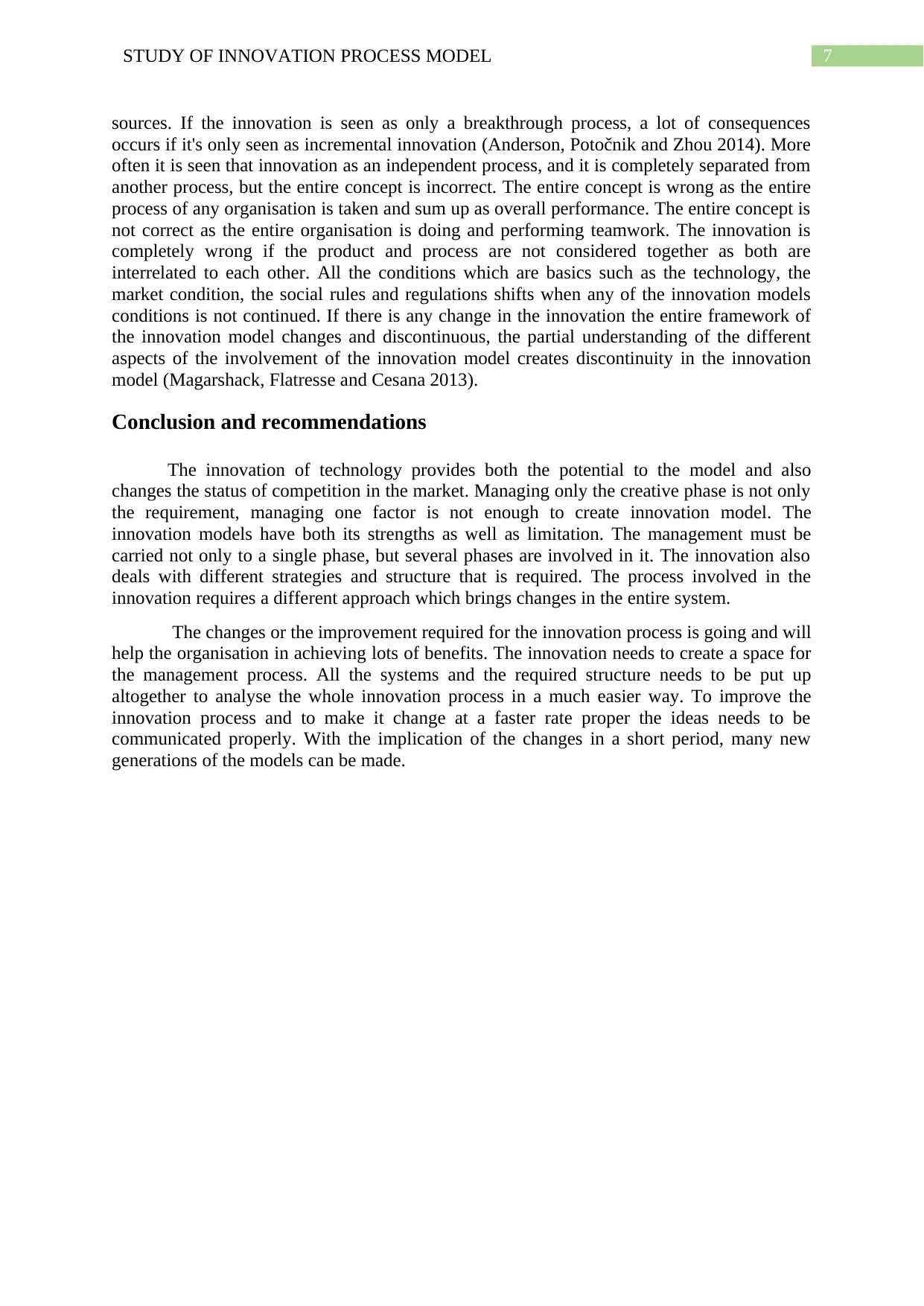
7STUDY OF INNOVATION PROCESS MODEL
sources. If the innovation is seen as only a breakthrough process, a lot of consequences
occurs if it's only seen as incremental innovation (Anderson, Potočnik and Zhou 2014). More
often it is seen that innovation as an independent process, and it is completely separated from
another process, but the entire concept is incorrect. The entire concept is wrong as the entire
process of any organisation is taken and sum up as overall performance. The entire concept is
not correct as the entire organisation is doing and performing teamwork. The innovation is
completely wrong if the product and process are not considered together as both are
interrelated to each other. All the conditions which are basics such as the technology, the
market condition, the social rules and regulations shifts when any of the innovation models
conditions is not continued. If there is any change in the innovation the entire framework of
the innovation model changes and discontinuous, the partial understanding of the different
aspects of the involvement of the innovation model creates discontinuity in the innovation
model (Magarshack, Flatresse and Cesana 2013).
Conclusion and recommendations
The innovation of technology provides both the potential to the model and also
changes the status of competition in the market. Managing only the creative phase is not only
the requirement, managing one factor is not enough to create innovation model. The
innovation models have both its strengths as well as limitation. The management must be
carried not only to a single phase, but several phases are involved in it. The innovation also
deals with different strategies and structure that is required. The process involved in the
innovation requires a different approach which brings changes in the entire system.
The changes or the improvement required for the innovation process is going and will
help the organisation in achieving lots of benefits. The innovation needs to create a space for
the management process. All the systems and the required structure needs to be put up
altogether to analyse the whole innovation process in a much easier way. To improve the
innovation process and to make it change at a faster rate proper the ideas needs to be
communicated properly. With the implication of the changes in a short period, many new
generations of the models can be made.
sources. If the innovation is seen as only a breakthrough process, a lot of consequences
occurs if it's only seen as incremental innovation (Anderson, Potočnik and Zhou 2014). More
often it is seen that innovation as an independent process, and it is completely separated from
another process, but the entire concept is incorrect. The entire concept is wrong as the entire
process of any organisation is taken and sum up as overall performance. The entire concept is
not correct as the entire organisation is doing and performing teamwork. The innovation is
completely wrong if the product and process are not considered together as both are
interrelated to each other. All the conditions which are basics such as the technology, the
market condition, the social rules and regulations shifts when any of the innovation models
conditions is not continued. If there is any change in the innovation the entire framework of
the innovation model changes and discontinuous, the partial understanding of the different
aspects of the involvement of the innovation model creates discontinuity in the innovation
model (Magarshack, Flatresse and Cesana 2013).
Conclusion and recommendations
The innovation of technology provides both the potential to the model and also
changes the status of competition in the market. Managing only the creative phase is not only
the requirement, managing one factor is not enough to create innovation model. The
innovation models have both its strengths as well as limitation. The management must be
carried not only to a single phase, but several phases are involved in it. The innovation also
deals with different strategies and structure that is required. The process involved in the
innovation requires a different approach which brings changes in the entire system.
The changes or the improvement required for the innovation process is going and will
help the organisation in achieving lots of benefits. The innovation needs to create a space for
the management process. All the systems and the required structure needs to be put up
altogether to analyse the whole innovation process in a much easier way. To improve the
innovation process and to make it change at a faster rate proper the ideas needs to be
communicated properly. With the implication of the changes in a short period, many new
generations of the models can be made.
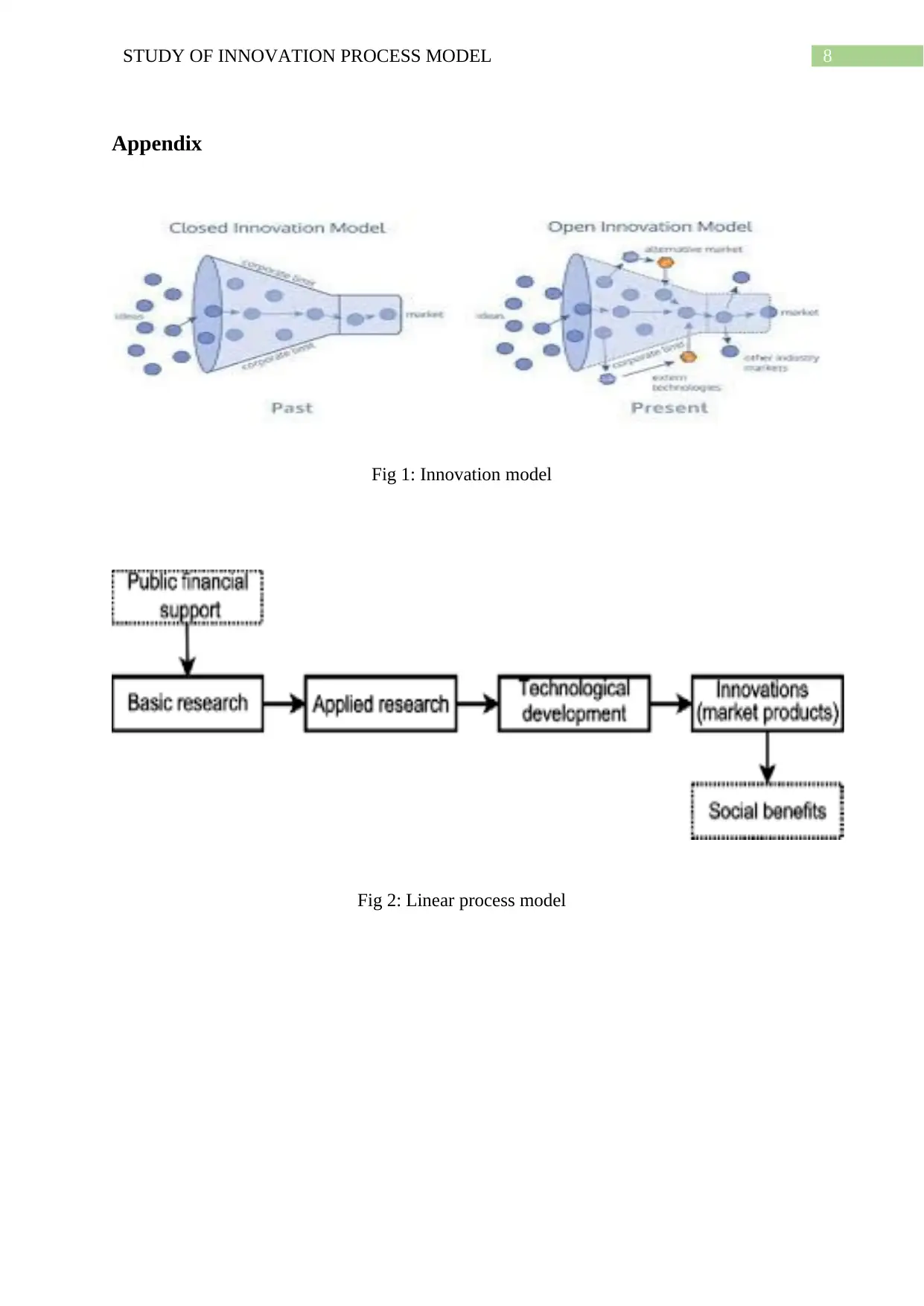
8STUDY OF INNOVATION PROCESS MODEL
Appendix
Fig 1: Innovation model
Fig 2: Linear process model
Appendix
Fig 1: Innovation model
Fig 2: Linear process model
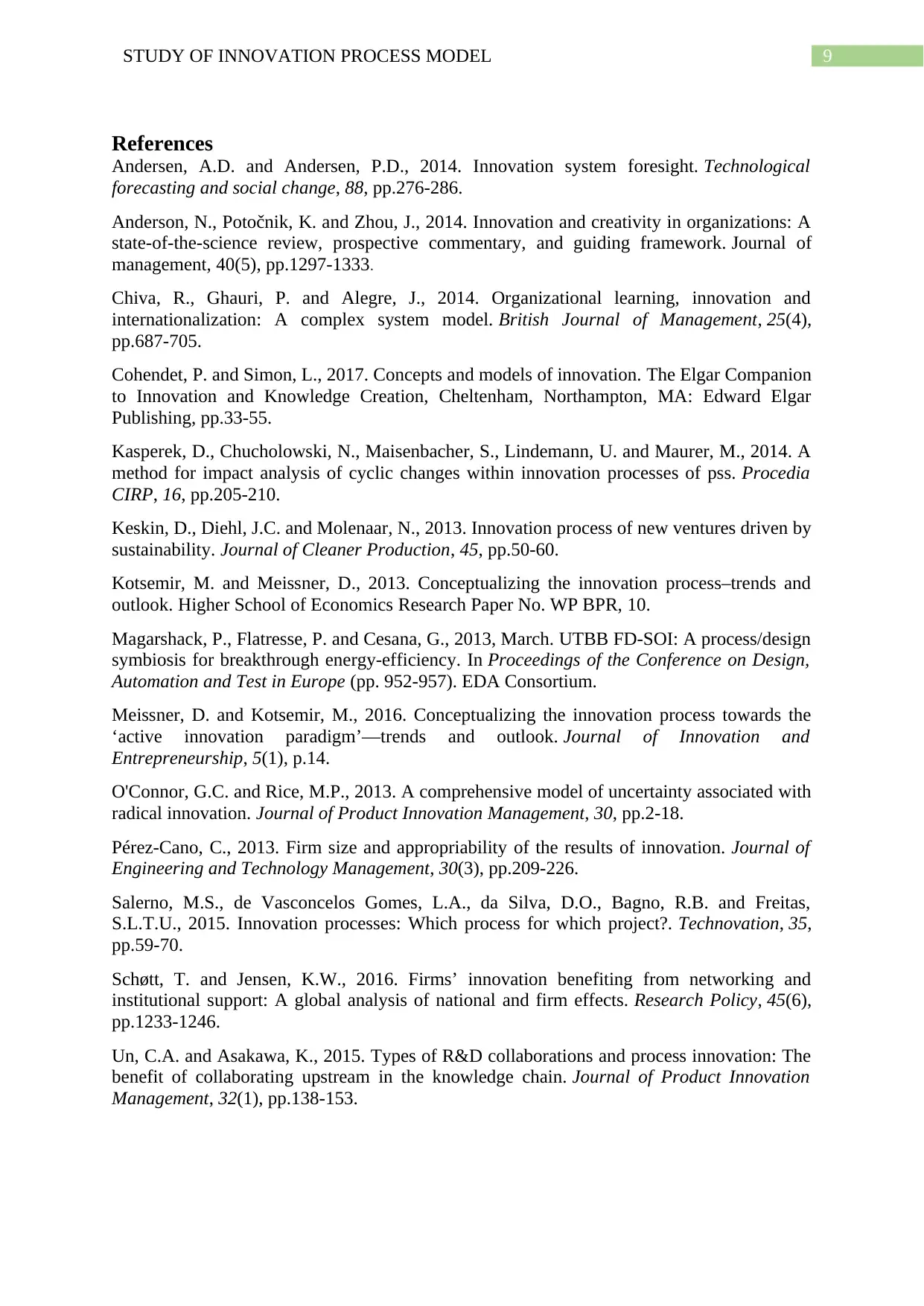
9STUDY OF INNOVATION PROCESS MODEL
References
Andersen, A.D. and Andersen, P.D., 2014. Innovation system foresight. Technological
forecasting and social change, 88, pp.276-286.
Anderson, N., Potočnik, K. and Zhou, J., 2014. Innovation and creativity in organizations: A
state-of-the-science review, prospective commentary, and guiding framework. Journal of
management, 40(5), pp.1297-1333.
Chiva, R., Ghauri, P. and Alegre, J., 2014. Organizational learning, innovation and
internationalization: A complex system model. British Journal of Management, 25(4),
pp.687-705.
Cohendet, P. and Simon, L., 2017. Concepts and models of innovation. The Elgar Companion
to Innovation and Knowledge Creation, Cheltenham, Northampton, MA: Edward Elgar
Publishing, pp.33-55.
Kasperek, D., Chucholowski, N., Maisenbacher, S., Lindemann, U. and Maurer, M., 2014. A
method for impact analysis of cyclic changes within innovation processes of pss. Procedia
CIRP, 16, pp.205-210.
Keskin, D., Diehl, J.C. and Molenaar, N., 2013. Innovation process of new ventures driven by
sustainability. Journal of Cleaner Production, 45, pp.50-60.
Kotsemir, M. and Meissner, D., 2013. Conceptualizing the innovation process–trends and
outlook. Higher School of Economics Research Paper No. WP BPR, 10.
Magarshack, P., Flatresse, P. and Cesana, G., 2013, March. UTBB FD-SOI: A process/design
symbiosis for breakthrough energy-efficiency. In Proceedings of the Conference on Design,
Automation and Test in Europe (pp. 952-957). EDA Consortium.
Meissner, D. and Kotsemir, M., 2016. Conceptualizing the innovation process towards the
‘active innovation paradigm’—trends and outlook. Journal of Innovation and
Entrepreneurship, 5(1), p.14.
O'Connor, G.C. and Rice, M.P., 2013. A comprehensive model of uncertainty associated with
radical innovation. Journal of Product Innovation Management, 30, pp.2-18.
Pérez-Cano, C., 2013. Firm size and appropriability of the results of innovation. Journal of
Engineering and Technology Management, 30(3), pp.209-226.
Salerno, M.S., de Vasconcelos Gomes, L.A., da Silva, D.O., Bagno, R.B. and Freitas,
S.L.T.U., 2015. Innovation processes: Which process for which project?. Technovation, 35,
pp.59-70.
Schøtt, T. and Jensen, K.W., 2016. Firms’ innovation benefiting from networking and
institutional support: A global analysis of national and firm effects. Research Policy, 45(6),
pp.1233-1246.
Un, C.A. and Asakawa, K., 2015. Types of R&D collaborations and process innovation: The
benefit of collaborating upstream in the knowledge chain. Journal of Product Innovation
Management, 32(1), pp.138-153.
References
Andersen, A.D. and Andersen, P.D., 2014. Innovation system foresight. Technological
forecasting and social change, 88, pp.276-286.
Anderson, N., Potočnik, K. and Zhou, J., 2014. Innovation and creativity in organizations: A
state-of-the-science review, prospective commentary, and guiding framework. Journal of
management, 40(5), pp.1297-1333.
Chiva, R., Ghauri, P. and Alegre, J., 2014. Organizational learning, innovation and
internationalization: A complex system model. British Journal of Management, 25(4),
pp.687-705.
Cohendet, P. and Simon, L., 2017. Concepts and models of innovation. The Elgar Companion
to Innovation and Knowledge Creation, Cheltenham, Northampton, MA: Edward Elgar
Publishing, pp.33-55.
Kasperek, D., Chucholowski, N., Maisenbacher, S., Lindemann, U. and Maurer, M., 2014. A
method for impact analysis of cyclic changes within innovation processes of pss. Procedia
CIRP, 16, pp.205-210.
Keskin, D., Diehl, J.C. and Molenaar, N., 2013. Innovation process of new ventures driven by
sustainability. Journal of Cleaner Production, 45, pp.50-60.
Kotsemir, M. and Meissner, D., 2013. Conceptualizing the innovation process–trends and
outlook. Higher School of Economics Research Paper No. WP BPR, 10.
Magarshack, P., Flatresse, P. and Cesana, G., 2013, March. UTBB FD-SOI: A process/design
symbiosis for breakthrough energy-efficiency. In Proceedings of the Conference on Design,
Automation and Test in Europe (pp. 952-957). EDA Consortium.
Meissner, D. and Kotsemir, M., 2016. Conceptualizing the innovation process towards the
‘active innovation paradigm’—trends and outlook. Journal of Innovation and
Entrepreneurship, 5(1), p.14.
O'Connor, G.C. and Rice, M.P., 2013. A comprehensive model of uncertainty associated with
radical innovation. Journal of Product Innovation Management, 30, pp.2-18.
Pérez-Cano, C., 2013. Firm size and appropriability of the results of innovation. Journal of
Engineering and Technology Management, 30(3), pp.209-226.
Salerno, M.S., de Vasconcelos Gomes, L.A., da Silva, D.O., Bagno, R.B. and Freitas,
S.L.T.U., 2015. Innovation processes: Which process for which project?. Technovation, 35,
pp.59-70.
Schøtt, T. and Jensen, K.W., 2016. Firms’ innovation benefiting from networking and
institutional support: A global analysis of national and firm effects. Research Policy, 45(6),
pp.1233-1246.
Un, C.A. and Asakawa, K., 2015. Types of R&D collaborations and process innovation: The
benefit of collaborating upstream in the knowledge chain. Journal of Product Innovation
Management, 32(1), pp.138-153.
1 out of 10
Related Documents
Your All-in-One AI-Powered Toolkit for Academic Success.
+13062052269
info@desklib.com
Available 24*7 on WhatsApp / Email
![[object Object]](/_next/static/media/star-bottom.7253800d.svg)
Unlock your academic potential
© 2024 | Zucol Services PVT LTD | All rights reserved.





